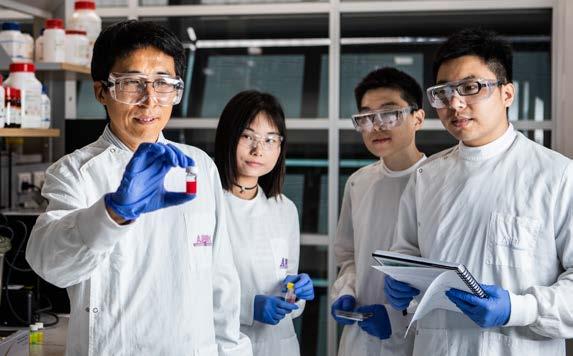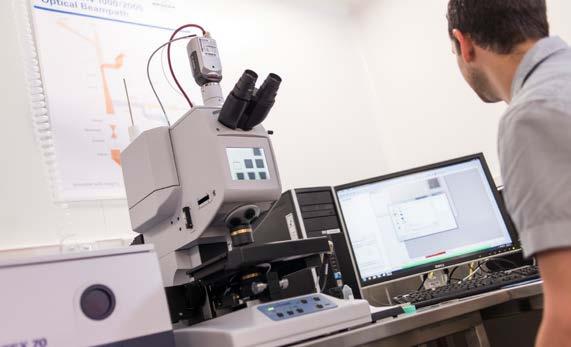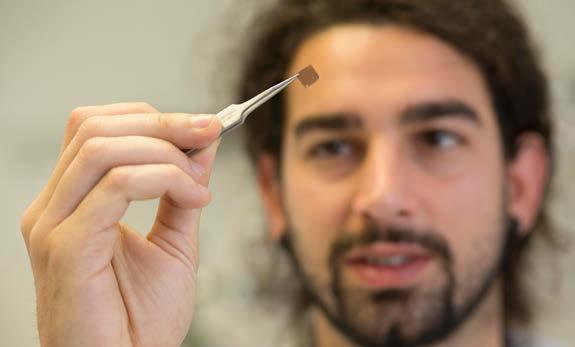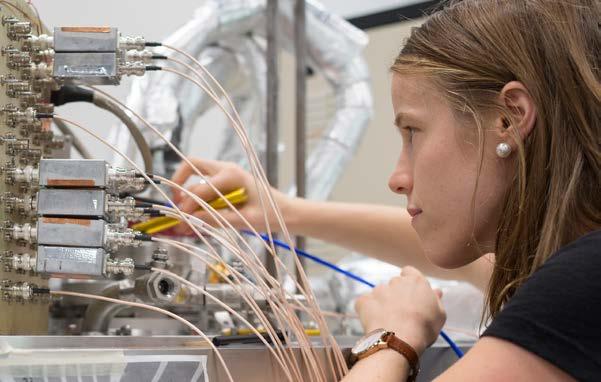
21 minute read
FEATURE: Nanotechnology
Nanotechnology broadly refers to the understanding and control of the physical, chemical and biological properties of matter at the nanoscale, at the dimensions between approximately one and 100 nanometres.
When observed at a nanoscale, gases, liquids and solids can exhibit physical, chemical and biological properties and behaviours that vastly differ to bulk matter. For example, some nanostructured materials may have different magnetic properties, be stronger or reflect light differently than the same material at other sizes or in other forms. Nanotechnology is an inherently multi-disciplinary field and draws together researchers from a variety of fields. It is studied and employed across a wide range of disciplines, including physics, chemistry, biology, materials sciences, and almost all engineering disciplines. Nanotechnology employs the physical, chemical and biological understanding of the properties of materials on an atomic and near-atomic scale to create materials and functional systems with novel and unique capabilities and properties. As such, nanotechnology is often viewed as an extension of previously existing scientific fields, recasting them into the nanoscale. When studying nanotechnology there are two primary approaches. The first is a ‘bottom up’ approach, whereby materials and devices are designed and built from molecular components which assemble themselves chemically according to principles of molecular recognition. The second ‘top down’ approach occurs when larger entities are used to construct nanoobjects without atomic-level control. Nanotechnology has already had a profound impact upon myriad industries globally, particularly in sectors such as electronics, computing, communications, defence, energy, biomedicine, transport and manufacturing. As understanding of nanotechnology continues to develop, so too does its applications.
Benefits and Applications of Nanotechnology

Nanotechnology offers a range of fields and disciplines a variety of benefits. It has already been able to improve and, in some cases, revolutionise technology and industry sectors. Just some of the fields that have benefited from nanotechnology include information technology, security, medicine, transportation, energy,

food safety, manufacturing and environmental science. One of the greatest benefits that nanotechnology offers is that it is able to enhance or unleash properties of materials which enable them to be used in innovative and novel ways. For example, nanotechnology can be used to make materials stronger, lighter, more durable, more reactive, or better at conducting electricity. As such, many commercial products rely on nanotechnology to be able to perform their function. Nanotechnology is used in a variety of both every day and sector-specific materials and processes, including:
Nanoscale additives are added to the surface treatments of some fabrics in order to help the resist staining, wrinkling or bacterial growth, or to provide lightweight ballistic energy deflection to personal body armour.
Nanoscale films, which are completely transparent, can be added to camera and computer displays, windows, eye glasses and other surfaces, making them water-resistant or water-repellent, antireflective, self-cleaning, anti-fog, scratch resistant, ultraviolet and infrared light resistant, antimicrobial, or electrically conductive.
Nanotechnology is being used to make a wide variety of products and materials more lightweight. By adding nanoscale composite polymers to items such as baseball bats, motorcycle helmets, bicycles, tennis rackets, luggage and automobile parts are able to be made lighter, stiffer, more durable and more resilient.
When used for cars, airplanes, trucks, boats and space craft, nanotechnology offers the possibility of significant fuel savings.
Nanotechnology can help to significantly extend the lifetime moving parts necessary for the function of power tools, industrial machines and much more. This is because nanostructured ceramic coatings are much tougher than other types of wear-resistant coatings for machine parts. Furthermore, lubricants made with nanotechnology and engine oils can greatly reduce machinery wear and tear.
Nanotechnology has been incorporated into many personal care products and cosmetics to improve their performance. For example, nanoscale titanium dioxide and zinc oxide are used in sunscreen to protect skin cells from ultraviolet radiation while appearing invisible.
A History of Nanotechnology
While nanotechnology is often perceived to be a recently developed field, early examples of nanotechnology exist as early as the 4th century. Though comparatively crude compared to our modern understanding of nanotechnologies, these early examples often used high heat to produce materials and objects with novel properties. From the 6th to 15th centuries, stained glass windows were incredibly popular in European cathedrals. Their rich colours were able to be achieved with nanoparticles of gold chloride and other metal oxides and chlorides. From the 13th to 18th centuries, Damascus steel, which was used for forging blades and swords, contained carbon nanotubes and cementite nanowires. These blades were known for their strength, resilience and ability to hold a keen edge. More recently, a significant development in the realm of nanotechnology occurred in 1938 when Edward Müller invented the field emissions microscope at the Siemens Research Laboratory. This discovery enabled the near-atomic resolution of materials. Müller again greatly contributed to the field of nanotechnology in 1951 with the development of the field ion microscope, which provided the means to image the arrangement of atoms at the surface of a sharp metal tip. In 1959, Richard Feynman gave a seminal lecture at the Californian Institute of Technology. This lecture, titled ‘There’s Plenty of Room at the Bottom’ is widely regarded to be the first on the topic of technology and engineering at the atomic scale. It wasn’t until 1974, however, that the term ‘nanotechnology’ was coined by Professor Norio Taniguchi from Tokyo Science University, who used it to describe the precision machining of materials to within atomic-scale dimensional tolerances. In 1981, the scanning tunnelling microscope was invented by Gerd Binning and Heinrich Rohrer, which allowed scientists, for the first time, to ‘see’ individual atoms. Gerd Binning, with the help of Calvin Quate and Christoph Gerber, went on to invent the atomic force microscope in 1986, which enabled scientists to view, capture and manipulate materials down to fractions of a nanometre in size. This included the measurement of forces that are intrinsic to nanomaterials. The 1990s saw the expansion and widespread development of nanotechnologies as early nanotechnology companies, such as Nanophase Technologies and Helix Energy Solutions Group, began to operate.

Since their inception, nanotechnologies have come a long way with significant developments and discoveries regularly being made. As nanotechnology research continues, the applications and benefits of nanotechnologies will continue to be uncovered, which will undoubtedly prove useful across a variety of industry sectors.
Nanotechnology Research Overview
Technological advancements across various fields over the past few decades have provided the tools necessary to undertake research at the nanoscale. Nanotechnology research is, by its very nature, inherently multidisciplinary. In order for the full potential of nanotechnology to be unveiled, it is necessary that researchers from varying fields cross traditional boundaries and are brought together to collaborate. Since the 1990s, nanotechnology has developed as a strong research field. This is because researchers, funding bodies, regulators and governments alike have recognised the potential nanotechnology has to revolutionise multiple industries, from computers to medicine. Nanotechnology research is necessary for the commercial integration and implementation of nanotechnology, which can ultimately offer myriad social, economic and environmental benefits.
Nanotechnology Research in Australia
University of Queensland
In 2003, the University of Queensland established their Nanomaterials Centre in order to focus on the emerging field of nanomaterials research. Since its inception, the Centre has evolved and grown to become a large, multi-disciplinary group. Currently, the research centre’s focus is primarily in the area of the synthesis and characterisation of nanomaterials in the key areas of environment, energy, and health. Nanomaterials offer the potential to provide the solution to many environmental issues, which is why the current environmental research being undertaken at the Centre is focused on the conversion of biofuels and chemicals, and applications in agriculture and veterinary science. In particular, nanoparticles can be used for crop modification and virus protection, which can help to improve crop protection and production. Moreover, nanoparticles can improve animal health through vaccination as well as improving the efficiency of herbicide use. The Centre is also undertaking research regarding the potential for nanomaterials in the field of clean energy generation, storage and applications. This is a particularly pertinent field of research given that climate change and the dwindling sources of fossil fuels are some of the most pressing challenges that society currently faces. Regarding nanomaterial research in the area of clean energy, the Centre has three main focuses: energy storage, solar cell,


and photocatalysis. In particular, the Centre’s research aims to develop nanomaterials for rechargeable batteries with high performance, long-term stability and low cost. The Centre is also exploring the potential applications of nanotechnology in commercial products, particularly in integrated electronic devices. Finally, the Centre focuses nanomaterial research efforts in the area of health care for the development of novel biomedical technologies, for drug, protein and gene delivery, as well as materials for biosensing.
University of Queensland (UQ) researchers set a world record for the conversion of solar energy to electricity via the use of tiny nanoparticles called ‘quantum dots’, which pass electrons between one another and generate electrical current when exposed to solar energy in a solar cell device.

Monash University
Monash University conducts a vast amount of research in the field of nanotechnology and nanomaterials across multiple departments. Within these departments, nanotechnology and nanomaterials research is wide and varied. Within the department of Mechanical and Aerospace Engineering, micro and nanoengineering research covers a diverse array of areas, including the mechanisms of microswimmers, microfabricated devices for handling cell, optical sensors, and graphene supercapacitators. Within this department, Dr Victor Cadarso Busto is undertaking research in the development of novel and scalable technologies for the fabrication of functional surfaces and 3D complex structures for a variety of applications, including optical MEMS, biomedical devices, environmental monitoring and sensing platforms. Professor Adrian Neild is researching microfluids and microsensors for applications in biomedical devices and instrumentation. Additionally, research undertaken by Dr Prabhakar Ranganathan uses modelling and computation to study complex behaviour that emerges from micromechanical interactions of soft materials such as polymer molecules, protein filaments or bilayer membranes, with a fluid environment. Within the department of Chemical Engineering, nanomaterials research focuses on the ability to synthesise, characterise and control the nanoscale structure of materials. This has the potential to revolutionise traditional fields of chemical engineering by moving process considerations from a macroscale to one that considers that the molecular and nanoscale interaction is an intrinsic part of the design. Nanomaterials are employed by researchers in the department of Chemical Engineering for a wide variety of applications, including corrosion mitigation, water purification, catalysis, sensors, drug and gene delivery, smart coatings, functional food, theranostics, gas separation, and material composites. Within the department of Materials Science and Engineering, nanostructured materials is a key area of research within the research theme of Functional and Energy Materials. In particular, areas of expertise include catalysts, sensor materials, nanostructured devices and fabrication, nanoparticles and nanocomposites, and nanostructured magnetic materials.
Monash University’s Engineering building at their Clayton campus.

Australian National University
At the Australian National University (ANU) nanotechnology and nanomaterials research is conducted across several fields and departments. Within the Materials Engineering department, fundamental and applied research is being undertaken on the development of unique synthesis techniques and novel applications of nanomaterials. This research into the applications of advanced nanomaterials is wide-ranging and includes catalysts, renewable energy and energy storage, biomedical materials, pollutant removal, and medical imaging and diagnostics.
They aim to create innovative nano applications that are sustainable at all life cycle stages, such as manufacturing, recycling and disposal processes. One of their main strengths is the commercialisation of applications to deliver technological innovations to the public. This is thanks to their experts who have first-hand experience in translating nanotechnology from the laboratory to industrial-scale manufacture. Within the Fabrication Engineering department, research is being undertaken in the creation of smart micro and nanoelectro-mechanical systems (MEMS and NEMS). This is done through the integration of tiny devices, which can enable many additional functionalities, from computing, sensing and communications, to energy harvesting. Through multidisciplinary research that combines materials science, chemistry and biomedical science, ANU’s research addresses the fields of MEMS and NEMS, nanomanufacturing, energy harvesting and biomedical sensing. Specific research topics include high-throughput nanomanufacturing technology, novel NEMS-based biomedical devices, nonlinearity engineering for NEMS, high-efficiency nanostructured thin-film solar cells, and NEMS with new twodimensional nanomaterials. One of the significant developments achieved by ANU scientists in the field of nanotechnology has been the design of ultra-small optical sensors that offer the potential to develop wearable devices that will allow doctors to medically detect and diagnose health problems and diseases, such as diabetes, much earlier than is currently possible.
Dr Mohsen Rahmani and Zelio Fusco. Image credit: Lannon Harley, ANU.

Dr Mohsen Rahmani, Zelio Fusco, and Associate Professor Antonio Tricoli. Image credit: Lannon Harley, ANU.

Swinburne University
Swinburne University is home to the Nanofabrication Laboratory (or Nano Lab), which facilitates research and education in nanotechnology, and is the first laboratory in the world to combine two complementary techniques that have the potential to enable two- and three-dimensional fabrication and modification of nanoparticles. Researchers and collaborators at the Nano Lab explore a wide range of phenomena, including light propagation, absorption and scattering by nanoparticles and nanostructures, and the efficiency of nanofabrication. Specifically, areas of research include solar cells, light harvesting, and fabrication of surfaces for photo-catalytic application. Research undertaken at the Nano Lab has already led to significant outcomes, including: the mass production of sensors that can be used for the detection of Alzheimer’s bio-markers; development of black silicon – nano spikey surfaces of silicon – which has a bactericidal effect and has biomedical applications; and the creation of unique and novel nanomaterials using ultra-short laser pulses. Currently, the Nano Lab is exploring 3D printing of bio-scaffolds using ultra-fast laser fabrication and using laser fabrication nanoparticles for sensing. This research offers nanomedicine a vast amount of potential. Additionally, Swinburne Optics and Laser Laboratories (SOLL) is home to the Microfabrication Facility, which is used for the preparation of samples, the deposition of dielectric and metal films, and the analysis of surface morphology and texture. The centre’s activity primarily focuses on the preparation and characterisation of nanomagnetic thin films for atom optics, and consulting work involving the preparation and characterisation techniques of various thin films, metals, and bio-materials.

Dr Vini Gautam from the Research School of Engineering at ANU. Image credit: Stuart Hay, ANU.



Deakin University
Deakin University is home to the Institute for Frontier Materials (IFM). One of IFM’s key strengths and research areas is in the development of novel micro and nanomaterials in order to address major challenges in the areas of energy storage, environmental protection, and health and medicine.
A significant development made by IFM researchers was their commercialisation of boron nitride nanotubes, which is a material that has excellent mechanical performance and thermal conductivity. This research has significant environmental applications, including for water resource protection by removing solvents, dyes and other contaminants.
Furthermore, IFM’s development of micro and nano-porous membrane materials has the potential to help address future environmental and biomedical challenges. Through research that focuses on the fabrication and characterisation of membranes with unique micro and nanostructures and surface properties, developments can be made in areas such as biological purification, gas separation and water treatment. The TERI Deakin Nanobiotechnology Centre (TDNBC), which was established in 2010, is a collaboration between Deakin University and India’s The Energy and Resources Institute (TERI). Research conducted at TDNBC uses Deakin’s expertise in nanotechnology deals with food security issues in increasingly changing climates, remediation of polluted environments through natural products, improving health through novel molecules, and improving the quality of life for poor communities. TDNBC aims to achieve sustainable agricultural practices, produce safe nanodelivery systems and affordable diagnostics for agriculture and human health, mitigate environment-related problems, and develop cleaner energy. One example of the flagship activities undertaken by TDNBC is in agriculture technology. Research is being undertaken in the areas of future biopharmaceutical formulations, pathogen and plant disease diagnostics, biological seed coating, biotic stress, and post-harvest management. IFM researchers have found a way to extract silicon from discarded solar panels and repurpose it into nano-silicon for batteries. Working with a local company, they recover the silicon from waste solar panels and then nano-size it, ready for use in lithiumion batteries. This is key to repurposing discarded solar cells and will prevent high-value waste going to landfill. The project has received a $150,000 grant from Sustainability Victoria, working with local company Delaminating Resources.


Dr Qiran Cai (L) and Dr Luhua Li discovered that atomically thin boron nitride had a very high thermal conductivity which could help cool electronics for optimum performance.
Breakthrough deals with overheating in electronic devices
IFM researchers have made a breakthrough discovery in the area of thermal conductivity and heat regulation, which will pave the way for the next generation of foldable phones, wearable technology and miniaturised electronics.
Dr Luhua Li and Dr Qiran Cai partnered with researchers from Northern Ireland and Japan to pioneer development of a highly thermally conductive and chemically stable material to help deal with overheating issues in modern devices. Heat management is a critical issue in miniaturised modern devices and most people will have experienced devices overheating, such as when a phone gets hot or a laptop’s internal fan starts whirring madly. With emerging technology such as foldable phones, micro-machines and wearable devices, thermal cooling has become critical for the performance, reliability, longevity, and safety of various products. Scientists are striving to come up with alternatives to aluminium and copper, which are conductive and potentially cause short circuit problems. Electrically insulating materials such as diamond and boron arsenide have been shown to work, but they are too rigid and inflexible, as well as too expensive for mainstream use. By taking a chemical compound known as boron nitride (BN) and shaving it down to an atomically-thin level, the researchers were able to give the material the desired flexibility while dramatically increasing its thermal conductivity and cooling capabilities. Atomically thin BN has better thermal conductivity than most semiconductors and insulators, along with low density, outstanding strength, high flexibility and stretchability, good stability, and excellent impermeability, making it a promising material for heat dissipation in next generation devices. This is a fundamental breakthrough, and with time and further research it will help to open up the boundaries of what’s possible in electronic devices – particularly as the trend in next generation electronics will most likely need to be flexible. Highlight publication: High thermal conductivity of high-quality monolayer boron nitride and its thermal expansion. Q. Cai, D. Scullion, W. Gan, A. Falin, S. Zhang, K. Watanabe, T. Tanaguchi, Y. Chen, E. Santos and L. Li. Science Advances 5 (6), eaav0129.
Queensland University of Technology
At the Queensland University of Technology (QUT) research is being undertaken by the Molecular Recognition and Sensors team in the development and application of nanotechnology for identification and quantification of selected analytes. The three primary research themes currently being investigated are Nanosensors and Molecular Diagnostics, Environmental and Nanoanayltics, and Light and Nanoplasmonics. Research regarding Nanosensors and Molecular Diagnostics is primarily concerned with the design and manufacture of nanosensors and their application in diagnostic, medical and other fields. Projects under this theme include:
Constructing chiral sensors for rapid detection and enantiomeric analysis of illicit drugs
Next generation biomedical sensors
Novel nanoscale platforms for the isolation and ultra-trace detection of bioactive molecules
Functionalised RNA aptamer nanoparticles for ultra-trace detection of target analytes in biological samples via Surface
Enhanced Raman Spectroscopy (SERS)
Rapid detection and differentiation of
Erythropoietin (EPO) isoforms in blood by handheld Raman and electrochemical devices
Development of a Point Of Care (POC) test system for the quantification of amino acids in medical conditions
Novel nanoformulations and nanosensors for lung delivery and molecular diagnosis of antibiotics and protein therapies
The theme of Environmental and Nanoanalytics researches the application of nanosensing technologies in an environmental monitoring context. Projects under this theme include:
Cost effective direct osmosis system for water desalination in gas mining
Ultra-trace detection of environmental toxicants using nanosensors
Synthesis and application of novel fluorescent probes for the rapid spectroscopic detection of metal ions and bioactive molecules Finally, the theme of Light and Nanoplasmonics aims to design and establish optical assemblies, and fabricate nanostructured materials that allow a

diverse array of light-material interactions to be investigated.
University of New South Wales
The University of New South Wales (UNSW) undertakes extensive research in the field of cancer nanotechnology. By working at the interface of chemistry and physics, researchers at UNSW are able to pioneer novel approaches to targeted and triggered therapeutics and cancer-specific imaging. Using nanomaterials that are built from clinically approved components, integration into clinical practice is enabled. Furthermore, the co-director of UNSW Sydney’s Centre for Healthy Brain Ageing (CHeBA), Professor Perminder Sachdev AM, has undertaken significant research in the field of using nanotechnology for dementia diagnosis and treatment. Professor Sadchev proposes that nanoparticles be used to move across the blood brain barrier to target dementia-specific molecules in the brain. Scientia Fellow, Dr Rona Chandrawati’s research focuses on the development of nantechnology sensors with colourimetric detection, which would be particularly pertinent in the areas of food and health. In particular, Dr Chandrawti’s hopes to develop technology which will enable the early detection of health issues. Additionally, they aim to develop technology which will indicate whether food is still safe to be consumed. Additionally, UNSW researchers have developed a method that accurately measures DNA nanostructures, and discovered how to fold these materials into different shapes. This has the potential to provide technological improvements by improving resolution, speed and precision of machines and tools.
University of Western Australia
One of the primary areas of nanotechnology at the University of Western Australia (UWA) is in biomaterials and nano-dentistry. This research aims to translate biomaterials and nanotechnology research to clinical dentistry in order to provide superior dental treatment to patients. Currently, research is focused on drug delivery to dental tissues through nanocarriers for preventative and restorative therapies, bioengineering dental hard tissues, the interaction of high intensity focused ultrasound with tooth structure, and 3D bio-printing for the repair of dental tissues. Current and proposed biomaterials and nano-dentistry projects include:
Drug delivery to dentin-pulp complex using nanocarriers
Bioengineering of dental hard tissues for the therapeutic and preventative dental applications
The interaction of HIFU and dental hard tissues 3D printing of biomaterials scaffolds for dental tissues repair
Milled and 3D printed dental prosthetic appliances Furthermore, UWA is using nanotechnology in their research into the prevention, diagnosis and treatment of disease. In particular, they are conducting research into the commercialising of nanoparticle technology for drug delivery applications, which has the potential to enable the precise delivery of drugs to diseased cells for the treatment of cancer and other diseases through ‘loaded’ nanoparticles. UWA research is also employing nanotechnology to develop novel methodology and biological applications. The potential for this research includes the development of a multimodal and multiscale bioimaging platform based on complementary techniques, as well as developing an understanding of biological processes, such as molecular mechanisms of lipid transport, action mechanisms of pharmaceutical compounds, and the toxicology of nanomaterials.

University of Sydney
The University of Sydney’s Nano Institute combines expertise from a range of disciplines to take research in the field of nanoscience to new levels. Their current primary research projects include Grand Challenges, Frontier, Catalyst, and Kickstarter. The Sydney Nano Grand Challenges aims to use advances in nanotechnology and nanoscience to provide ground-breaking solutions to some of the world’s greatest challenges. These challenges include:
Developing a low-cost method to capture enough water from the atmosphere to alleviate the effect of drought by providing water for consumption to humans and animals, and for irrigating plants and crops.

Reducing CO 2 emissions in manufacturing processes and converting CO 2 into commercial products through nanocatalysis Developing a regulation framework to assess safety, efficacy and toxicity, and guide future development of nanomaterials, including in drug formulations, food additives and biosensors
Building autonomous, programmable nanorobots to navigate through the body to detect and treat early signs of disease Simulating new materials from a single atom to fully functioning devices using quantum computers, multiscale simulation, artificial intelligence and machine learning Specifically, research being undertaken by the Nano Institute includes researching the effects of nanoparticles on living organisms. This is critical in order to protect health as well as protect the sustainability and benefits that nanomaterials offer.
Furthermore, research is being conducted in the field of nanoengineered reversible energy storage. Through designing and fabricating nanodomains of electroactive materials, using self-assembly and electrode patterning, and the subsequent interrogation at nanoscale resolution through in situ methods, prototype devices have been developed. As a result, the spin-off company Gelion Technologies was established.

















